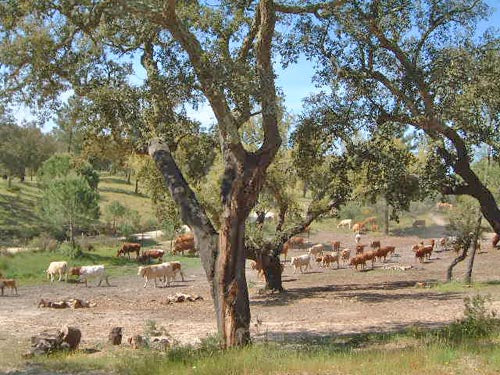
The cork we use in wine bottles and on our floors is harvested from trees - the cork oak tree. These trees grow in forests throughout the Mediterranean, including Portugal, Spain, southern France, Italy, and northern Africa. Cork trees flourish in these areas due to the very specific micro-climates and soil types of this region. Along with the cork trees come various plant and animal species that are dependent on these forests for continued survival.
Vast portions of Portugal are covered in montado or cork oak forests. Unlike the traditional forests of North America, the montado is a blend of trees and grassland, creating a home for a wide variety of animals. Due to the decline in some winemakers using real wine corks in favor of low cost synthetic (plastic) corks, many cork forests have been converted into agricultural farming or property development. This caused mass displacement of some of the animals of the cork forest. Some of these displaced animals are now listed as threatened or endangered species.
Many types of mammals call the cork forests home, including rabbits, weasels, deer, and mongoose. The trees themselves are home to kestrels, little owls, black storks, and many more. Species of geckos, skinks, toads, and spiders also make their home in the montado.
We are going to focus on four animals that live in the cork forest and are endangered.
- The Iberian Lynx (Spain and Portugal)
- The Barbary Macaque (Northern Africa)
- The Spanish Imperial Eagle ( Spain and Portugal)
- The Iberian Wolf (Spain)
The Iberian Lynx is critically endangered. According to the WWF, this is the world's most endangered feline, with only 400 lynx in the wild. On a hopeful note, this number is up from the mid-2000s when fewer than 200 lynx lived in the wild. Besides being a critically endangered species, the Iberian Lynx is also extremely stealthy, so you will likely not see one if you make a trip to a cork forest. Learn more about the Iberian Lynx and efforts underway to protect them!
WWF has been calling for the implementation of measures to help rabbit populations to recover, since this will benefit the lynx and other Mediterranean forest species. It is all part of our work to save the lynx, which began in 2002 in the cat’s main haven in Sierra de Andújar. Since then, we have successfully restored the territories of 8 female lynxes in that critical habitat and celebrated the birth of over 50 kittens. - WWF website
The Barbary Macaque lives in Northern Africa and is the only species of macaque that lives outside of Asia. The IUCN estimates there are only between 8,000 and 10,000 barbary macaques living in the wild. Even more concerning is that Barbary Macaques are continuing to decline in the wild. The Barbary Macaque Awareness and Conservation website has lots of information about the Barbay Macaque and how to help them in their mission.
The Spanish Imperial Eagle was considered critically endangered in the 1960s when it was estimated only 30 pairs were remaining. Today we estimate that there are between 300 and 400 Spanish Imperial Eagles in the wild and classified as vulnerable. Learn more about the Spanish Imperial Eagle.
The Iberian Wolf is a comparatively small wolf species. They live in a relatively small geographic area comprising parts of northern Portugal, the Cantabrian Mountains, and other parts of Central Spain. They are listed as a vulnerable species with an estimated 700 adult Iberian Wolf in the wild. The Barcelona Zoo works with the European Endangered Species Programme and is a great place to learn more about the Iberian Wolf.
Cork forests also have one of the highest levels of plant diversity in the world. According to panda.org (WWF's website), plant diversity in cork forests can reach 135 species every square meter. Some of these plants include fungi (some edible), lavender, rosemary, and rockrose bushes. Many of these plants are endemic to this region and exist only because of these trees.
So cork is much more than a wine stopper or bulletin board. It is even more than a renewable resource. Cork, and more specifically the trees it grows on, supports a plethora of species of flora and fauna. You can support the wildlife that makes the cork forest home by buying real cork products where possible.
Looking for more information about why buying cork is good for the environment? Check out our blog on "the myth".

